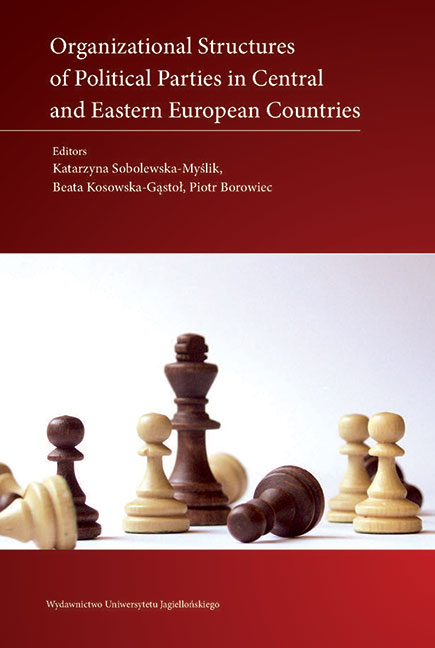Book contents
- Frontmatter
- Contents
- Preface
- Developing Party Structures in Central and Eastern Europe
- Albania: Organizations of Political Parties in Albania
- Belarus: Belarusian Political Parties: Organizational Structures and Practices
- Bosnia and Herzegovina: Organizational Structures of Political Parties in CEE Countries: A Case Study on Bosnia and Herzegovina
- Bulgaria: Organizational Structure and Trends in Bulgarian Party Politics
- Croatia: Organizational Structures of Political Parties in Croatia
- Czech Republic: Between Organizational Extremes: Czech Parties after a Political Earthquake
- Estonia: Organizational Structures of Political Parties in Estonia
- Hungary: Cut from the Same Cloth? A Comparative Analysis of Party Organizations in Hungary
- Kosovo: Structure of the Main Political Parties in Kosovo
- Latvia: Leader-Centered and Power-Hungry: Party Organizations in Latvia
- Lithuania: Organization of Political Parties: The Case of Lithuania
- Moldova: Organizational Structures of Political Parties in The Republic of Moldova
- Montenegro: Party Organization in Montenegro: Structural Resemblance Behind Political Divergence
- Poland: Structures of Polish Political Parties in the Second Decade of the 21st Century
- Romania: The Internal Organization of Romanian Political Parties
- Russia: Parties with Roots Growing Upwards: Organizational Features of Russian Political Parties
- Serbia: Organizational Structures of Political Parties in Serbia
- Slovakia: Organizational Structures of Political Parties in Slovakia: Parties not for Members
- Slovenia: Almost without Any Innovations: Organizational Structures in Slovenian Parties
- Ukraine: Shallow Party Structures in a Volatile Party System
- Comparing Organizational Structures of Political Parties in Central and Eastern European Countries
- Biographical notes about the authors
Hungary: Cut from the Same Cloth? A Comparative Analysis of Party Organizations in Hungary
- Frontmatter
- Contents
- Preface
- Developing Party Structures in Central and Eastern Europe
- Albania: Organizations of Political Parties in Albania
- Belarus: Belarusian Political Parties: Organizational Structures and Practices
- Bosnia and Herzegovina: Organizational Structures of Political Parties in CEE Countries: A Case Study on Bosnia and Herzegovina
- Bulgaria: Organizational Structure and Trends in Bulgarian Party Politics
- Croatia: Organizational Structures of Political Parties in Croatia
- Czech Republic: Between Organizational Extremes: Czech Parties after a Political Earthquake
- Estonia: Organizational Structures of Political Parties in Estonia
- Hungary: Cut from the Same Cloth? A Comparative Analysis of Party Organizations in Hungary
- Kosovo: Structure of the Main Political Parties in Kosovo
- Latvia: Leader-Centered and Power-Hungry: Party Organizations in Latvia
- Lithuania: Organization of Political Parties: The Case of Lithuania
- Moldova: Organizational Structures of Political Parties in The Republic of Moldova
- Montenegro: Party Organization in Montenegro: Structural Resemblance Behind Political Divergence
- Poland: Structures of Polish Political Parties in the Second Decade of the 21st Century
- Romania: The Internal Organization of Romanian Political Parties
- Russia: Parties with Roots Growing Upwards: Organizational Features of Russian Political Parties
- Serbia: Organizational Structures of Political Parties in Serbia
- Slovakia: Organizational Structures of Political Parties in Slovakia: Parties not for Members
- Slovenia: Almost without Any Innovations: Organizational Structures in Slovenian Parties
- Ukraine: Shallow Party Structures in a Volatile Party System
- Comparing Organizational Structures of Political Parties in Central and Eastern European Countries
- Biographical notes about the authors
Summary
Introduction
Hungary, as a post-communist country of Central and Eastern Europe, is characterized by strong anti-party attitudes and sentiment. Nevertheless, parties are still the key players in public life due to the amount of resources they possess and their level of centralization, being higher by orders of magnitudes than civic organizations, trade unions or movements could expect.
The party system is currently tripartite. The right-wing and conservative Alliance of Young Democrats (Fidesz) and its small satellite party, the Christian Democratic People's Party (KDNP) are located in one block and have been governing since 2010. Fidesz shows characteristics of the central party of dominant party systems, as (with the formally independent KDNP) it managed to acquire a supermajority (i.e. two-thirds of the seats in the National Assembly) in the last two elections. The leftist block is fragmented, with several left -wing and liberal parties. Among them, the two relevant ones discussed in this chapter are the Hungarian Socialist Party (MSZP), the successor to the communist state party; and the Democratic Coalition (DK), an MSZP splinter party, led by a former Prime Minister. While the latter lacks a parliamentary group, membership numbers and popular support are currently on the rise. Finally, Movement for a Better Hungary (Jobbik), classified as both a radical and far-right organization, is the sole party appealing to the voters of the third bloc.
Some authors interpret (Tóth and Török 2014) the party system as a continuum of a culturally and ideologically understood left and right, i.e. that all parties can be placed somewhere on an authoritarian–libertarian scale. Fidesz occupies a central position on the scale, with fragmented leftist opposition on its left, and a radical-extremist right represented by Jobbik. Others (Horváth and Soós 2015) believe structural differences between parties are deeper than mere shift s of cultural–ideological positions on a scale. According to this view, the relevant cleavages are the ones that separate Fidesz from the two oppositional blocks: open racism in the case of Jobbik; and differences in the majoritarian and liberal conceptions of democracy on the left. This approach also claims that the most important symbolic difference is the party label, understood as a “brand” itself.
- Type
- Chapter
- Information
- Organizational Structures of Political Parties in Central and Eastern European Countries , pp. 185 - 208Publisher: Jagiellonian University PressPrint publication year: 2017



